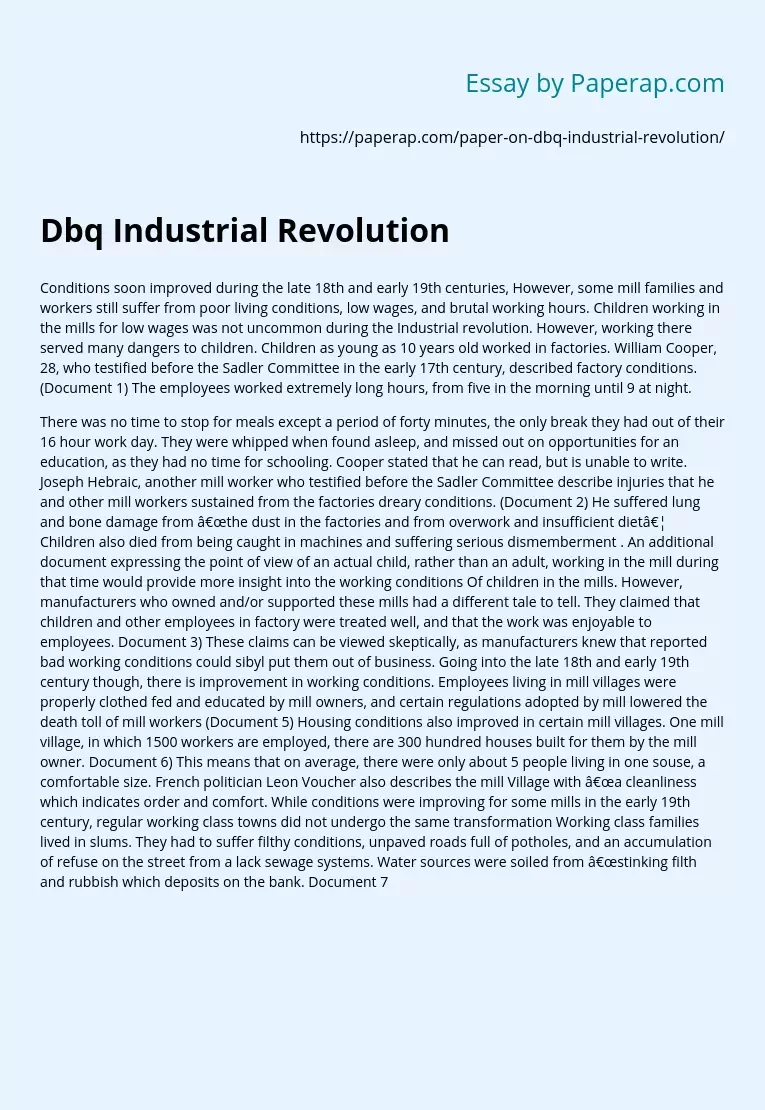Dbq Industrial Revolution
Conditions soon improved during the late 18th and early 19th centuries, However, some mill families and workers still suffer from poor living conditions, low wages, and brutal working hours. Children working in the mills for low wages was not uncommon during the Industrial revolution. However, working there served many dangers to children. Children as young as 10 years old worked in factories. William Cooper, 28, who testified before the Sadler Committee in the early 17th century, described factory conditions. (Document 1) The employees worked extremely long hours, from five in the morning until 9 at night.
There was no time to stop for meals except a period of forty minutes, the only break they had out of their 16 hour work day. They were whipped when found asleep, and missed out on opportunities for an education, as they had no time for schooling. Cooper stated that he can read, but is unable to write. Joseph Hebraic, another mill worker who testified before the Sadler Committee describe injuries that he and other mill workers sustained from the factories dreary conditions.
(Document 2) He suffered lung and bone damage from “the dust in the factories and from overwork and insufficient diet… Children also died from being caught in machines and suffering serious dismemberment . An additional document expressing the point of view of an actual child, rather than an adult, working in the mill during that time would provide more insight into the working conditions Of children in the mills. However, manufacturers who owned and/or supported these mills had a different tale to tell.
They claimed that children and other employees in factory were treated well, and that the work was enjoyable to employees. Document 3) These claims can be viewed skeptically, as manufacturers knew that reported bad working conditions could sibyl put them out of business. Going into the late 18th and early 19th century though, there is improvement in working conditions. Employees living in mill villages were properly clothed fed and educated by mill owners, and certain regulations adopted by mill lowered the death toll of mill workers (Document 5) Housing conditions also improved in certain mill villages. One mill village, in which 1500 workers are employed, there are 300 hundred houses built for them by the mill owner. Document 6) This means that on average, there were only about 5 people living in one souse, a comfortable size. French politician Leon Voucher also describes the mill Village with “a cleanliness which indicates order and comfort. While conditions were improving for some mills in the early 19th century, regular working class towns did not undergo the same transformation Working class families lived in slums. They had to suffer filthy conditions, unpaved roads full of potholes, and an accumulation of refuse on the street from a lack sewage systems. Water sources were soiled from “stinking filth and rubbish which deposits on the bank. Document 7) The visual from document shows a working class neighborhood in London. The air is thick with soot and smoke from factory chimneys. The houses are extremely small, and packed into tight childlike divisions separated by brick walls, with barely any space to spare. Workers during the industrial revolution suffered injuries, brutality, and inadequate live Eng conditions for their labor during the early 18th century. Although these conditions improved slightly during the late 17th and early 19th centuries, many working class neighborhoods in England continued to struggle with their living and working conditions.
Working And Living Conditions In The Industrial Revolution
Dbq Industrial Revolution. (2019, Dec 05). Retrieved from https://paperap.com/paper-on-dbq-industrial-revolution/

